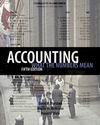 |  Accounting: What the Numbers Mean, 5/e David H. Marshall,
Millikin University
Wayne W. McManus,
International College of the Cayman Islands
Daniel F. Viele,
Webster University
The Income Statement and the Statement of Cash Flows
Chapter 9 Outline
Income Statement- Revenues
- Revenue recognition.
- Realized or realizable.
- Earned.
- Revenue from sales.
- Sales returns and allowances.
- Net sales.
- Revenue from services.
- Unusual revenue recognition methods.
- Percentage of completion.
- Expenses
- Expense recognition.
- Matching principle, objectivity, and conservatism applied.
- Cost of goods sold.
- Under perpetual inventory system.
- Under periodic inventory system.
- Purchases returns and allowances.
- Gross Profit or Gross Margin
- Expressed as dollar amount and percentage of net sales.
- Effect of sales mix.
- Use of gross profit ratio to estimate ending inventory and cost of goods
sold.
- Use of target gross profit ratio to set selling price.
- Other Operating Expenses
- Income from Operations
- Other Income and Expense
- Interest income and interest expense.
- Other gains and losses.
- Income Before Income Taxes and Income Tax Expense
- Net Income and Earnings Per Share
- Weighted average shares outstanding.
- Net income available for common stock.
- Basic versus diluted earnings per share.
- Summary of Income Statement Presentation Alternatives
- Single-step format.
- Multiple-step format.
- Unusual Items Sometimes Seen on the Income Statement
- Discontinued operations.
- Extraordinary items.
- Reported net of income tax effect.
- Minority interest in earnings of subsidiaries.
- Cumulative effect of a change in accounting principle.
|
 |  |  | Statement of Cash Flows- Content and Format of the Statement
- Cash providing/using activities.
- Operations.
- Investing.
- Financing.
- Net income--the beginning point for cash generated from operations, but
adjustments are required for non-cash elements of net income.
- Depreciation and amortization expense.
- Income tax expense not currently payable.
- Gains or losses on property sales.
- Changes in other current assets and current liabilities affect cash generated
from operating activities.
- Summary of investing activities.
- Summary of financing activities.
- Statement illustrated.
- Direct method.
- Indirect method.
- Interpreting the Statement of Cash Flows
- Look at category totals before looking at details.
- Operating activities--should generate cash.
- Investing activities--usually use less cash than is generated by operating
activities.
- Financing activities.
- Debt transactions--borrowings and repayments.
- Capital stock transactions--sale of stock and purchase of treasury stock.
- Dividends payments.
|
|


 2002 McGraw-Hill Higher Education
2002 McGraw-Hill Higher Education